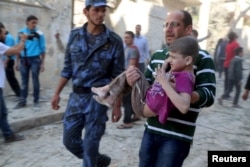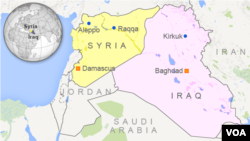Thirteen-year-old Ahmed and 11-year-old Nizar are, to some extent, fortunate — blasts from the barrel bombs dropped by Syrian helicopters only crumpled their bodies.
The Syrian Network for Human Rights reported Wednesday that Syrian forces dropped more than 1,700 barrel bombs in September, killing at least 103 people, including 25 children and 15 women. Unlike many children hit in those aerial attacks, Ahmed and Nizar survived to spend the rest of their lives adapting to the injuries.
Paralyzed from the chest down, Ahmed only recently started to use his hands and arms, but the rest of his fractured body will be forever useless. When he arrived here at the 47-bed post-operative field hospital run by the International Blue Crescent in Turkish border town of Kilis, he was inconsolable. His father and sister died in the Aleppo blast.
“He was very aggressive, very angry and without any movement in the forearms and his legs," said Ali Ahmed, a nurse. "After some treatment ... he is moving his hands. He's optimistic, but I think he is frightened to think in the future and the past.”
Smiling now, the pale boy shows how he uses his hands. Cradling the injured boy’s squirming 1-year-old brother by his bedside, Ahmed’s mother explains that he can now play video games on a tablet. He flashes a thumbs up — an act that has taken weeks to master — the result of his fortitude and the dedication of his Syrian refugee doctors.
First used in August 2012, the cheap-to-make barrel bombs — oil drums or canisters packed with TNT and an assortment of metal fragments or fuel or even toxic gases — were banned by a February 2014 U.N. Security Council resolution. But the crude devices have killed almost 9,000 people since the ban, 95 percent of whom were civilians. About one-third of civilian fatalities were children.
In the sun-dappled hospital courtyard, Nizar from Homs says he was playing outside with other kids when they heard an explosion and scattered. He dashed into a building but he was caught in a second blast.
The 11-year-old lost his right arm; his left is riddled by scarlet wounds and holes where the tendons are visible. He is not used to his injuries. As the brown-eyed, dark-haired boy talks, he raises the intact arm and stump in unison to emphasize a point.
Doctors here are numbed by the tragedies and ruefully wonder why four years after Syrians protested repression and asked for freedom, what they have in return are barrel bombs, jihadists, a Russian intervention and broken promises from the West.












